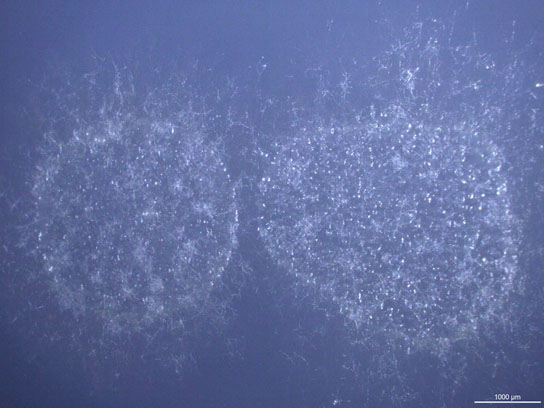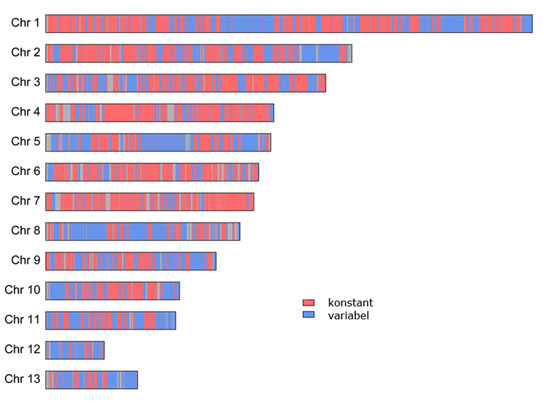
A newly published study from scientists at the Max Planck Institute for Terrestrial Microbiology in Marburg and Aarhus University in Denmark shows that new fungi, which can also be of significance to agriculture, can develop and successfully propagate extremely rapidly by natural hybridization.
Zymoseptoria tritici is often a headache for European farmers. This ascomycete originating from the Middle East attacks the leaves of wheat plants triggering “speckled leaf blotch”, which can cut crop yields by up to 50 percent. Scientists from the Max Planck Institute for Terrestrial Microbiology in Marburg and Aarhus University in Denmark have now taken a close look at the genome of a close relative, Zymoseptoria pseudotritici and have made a surprising discovery. The fungus which, unlike its more globally active cousin, preferentially attacks grasses in Iran, clearly arose just a few hundred years ago from the fusion of two unknown parent species. The researchers’ results make it clear that entirely new and successful pest species can arise extremely rapidly by natural hybridization.
If two different species breed successfully, the descendants are known as hybrids. While animal hybridization in the wild tends to be a short-lived exception, primarily because the offspring are frequently less fit or even infertile, in plants and fungi speciation by crossing is an “everyday” evolutionary event. However, what happens at the gene level was previously unknown: in naturally occurring hybrid species, the initial mixing of the genomes usually took place so long ago that almost no traces remain in the genetic material.
Eva Holtgrewe Stukenbrock’s team from the Max Planck Institute for Terrestrial Microbiology has now, for the first time, investigated the genome of a very recent hybrid population, in which, in evolutionary terms, hybridization has only just occurred. The researchers have sequenced and aligned the genomes of five individuals of the fungal species Zymoseptoria pseudotritici which originates from Iran. “This revealed an unusual pattern of diversity”, says Eva Stukenbrock. “We found numerous long regions that were identical in all the individuals. These were, however, regularly interspersed with highly variable segments.”
These variable segments could always be assigned to two different “haplogroups”, an individual comprising either one type or the other. The researchers soon worked out what had happened: these are the traces of a natural hybridization event in the past. The genetic material of both “parent species” has clearly been retained within the population in the variable gene segments, while the identical regions in each case retain only the genetic information from one of the parents.

But that’s not quite the whole story. By investigating the topology of the identical and variable segments, the degree of similarity and further characteristics of the genetic information, the scientists were able to reconstruct the entire evolutionary history of this recent fungal species. “The entire present day population originates from two individual parents from different species which crossed only once. Backcrossing between the parent species and the hybrids can certainly be ruled out”, explains Eva Stukenbrock. “We can also state that hybridization occurred around 380 generations ago. Given a typical rate of reproduction of at least once to around three times per year, speciation therefore occurred around 200 years ago.”
The identity of the two original parents remains unclear, however. “We could not identify any matching species from our Iranian sample collection. This may either be purely and simply because our samples do not reflect the entire range of pest diversity, or because the hybrid descendants have driven out the parent species”, she says. And this would not seem all that unlikely, as it is precisely in plants and fungi that new hybrids often have new characteristics that enable colonization of other habitats or even offer competitive advantages over pre-established species.
This study by the Marburg-based researchers shows that new fungi which can also be of significance to agriculture can develop and successfully propagate extremely rapidly. “World trade in agricultural products promotes the rapid evolution of plant pests”, says Eva Stukenbrock, “and this happens very simply by local fungal species, for example living on wheat, being unintentionally brought into contact with introduced species, which can then cross and form new species.”
Reference: “Fusion of two divergent fungal individuals led to the recent emergence of a unique widespread pathogen species” by Eva Holtgrewe Stukenbrock, Freddy Bugge Christiansen, Troels Toftebjerg Hansen, Julien Yann Dutheil and Mikkel Heide Schierup, 18 June 2012, Proceedings of the National Academy of Sciences.
DOI: 10.1073/pnas.1201403109